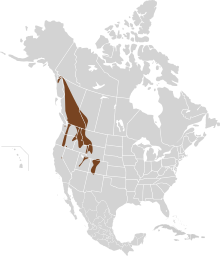User:Michellewang0520/Western heather vole
| This is the sandbox page where you will draft your initial Wikipedia contribution.
If you're starting a new article, you can develop it here until it's ready to go live. If you're working on improvements to an existing article, copy only one section at a time of the article to this sandbox to work on, and be sure to use an edit summary linking to the article you copied from. Do not copy over the entire article. You can find additional instructions here. Remember to save your work regularly using the "Publish page" button. (It just means 'save'; it will still be in the sandbox.) You can add bold formatting to your additions to differentiate them from existing content. |

The western heather vole (Phenacomys intermedius) is a small vole found in western North America. Until recently, the eastern heather vole, (Phenacomys ungava), was considered to be a subspecies.[1] Physically, their appear similar to the montane vole (Microtus montanus), to the extent that its genus name, Phenacomys, translates to "deceiver mouse".[2]
Characteristics[edit]
They have short ears with stiff orange hair inside and a short thin tail which is paler underneath. Their long soft fur is brownish with silver grey underparts. They are roughly 14 cm long with a tail length (approximately 50 mm) shorter than one-half their body length, and the voles weigh about 40 g. The hind feet have six plantar pads, while the forefeet have five.[2]
Their molars are uniquely shaped, with less deep buccal angles and deeper mandibular teeth angles. In particular, their first molar has large variability, with the amount of closed triangles observed to be from three to seven.[3]
Distribution and habitat[edit]
Western heather voles are found in alpine meadows, open shrubby areas, dry forests with shrubs below to provide cover and tundra regions. They are usually near water, and live primarily in British Columbia, the Yukon and the western United States.[4] Although many maps show the population as continuous, populations in the southern mountain regions are likely isolated.[5]
In summer, they live in underground burrows where they make nests of grasses and small foliage. These nests are usually near the surface, above 20 cm from the ground, and after often underneath objects such as rocks and logs. and, in winter, they tunnel under the snow. They store food for later use year-round.[2]
Behavior and ecology[edit]
They feed on plant leaves and berries in summer and plant bark and buds in winter, also seeds and fungi. Predators include owls, hawks and carnivorous mammals.[4] They are active year-round, and are found to be more crepuscular, being more active at twilight and at night than during the day.[6] When captured, western heather vole are docile and non-aggressive, though are generally more aggressive during breeding season.[6]
Reproduction[edit]
The female vole has 2 or 3 litters of 2 to 9 young in a nest made from grasses. Aside from western heather voles that live in high-elevations, which may exhibit shorter breeding seasons, their standard breeding season is from May to August. Both male and females are mature after one year and have a lifespan of 4 years or less.[2]
Population[edit]
The population of this animal has been reduced in some parts of its range because of clearcutting of forests. As also seen in other high-elevation populations, climate change and the resulting melting of ice sheets in habitats previously inhabited by western heather vole have caused the population and differentiation of populations within the species to decrease. Some populations have also migrated north due to global warming.[7], as during the Last Glacian Maxiumum, western heather voles have have populations much farther south than they are currently, some as far south as Tennessee and Arkansas.[4]
References[edit]
- ^ Braun, Janet K.; Gonzalez-Perez, Sara B.; Street, Garrett M.; Mook, Jennie M.; Czaplewski, Nicholas J. (16 December 2010). "Phenacomys ungava (Rodentia: Cricetidae)". Mammalian Species. 45 (899).
- ^ a b c d McAllister, James A.; Hoffmann, Robert S. (1988). "Phenacomys intermedius". Mammalian Species (305): 1–8. doi:10.2307/3504242. ISSN 0076-3519.
- ^ Howell, Alfred Bazier (1926). Voles of the Genus Phenacomys: I. Revision of the genus Phenacomys. II. Life history of the red tree mouse (Phenacomys longicaudus). North American Fauna 48. U.S. Fish and Wildlife Service. pp. 1–37.
- ^ a b c "Heather vole | Explore the Ice Age Midwest". iceage.museum.state.il.us. Retrieved 2022-10-13.
- ^ Hall, E. R. (23 November 1982). "THE MAMMALS OF NORTH AMERICA". Journal of Mammalogy. 63 (4) (2nd ed.). New York: John Wiley and Sons.
- ^ a b Smith, Donald; Foster, Bristol. "NOTES ON THE SMALL MAMMALS OF CHURCHILL, MANITOBA" (PDF). JOURNAL OF MAMMAOLOGY. 38 (1): 18.
- ^ Andreas S. Chavez, G. J. Kenagy, Historical biogeography of western heather voles (Phenacomys intermedius) in montane systems of the Pacific Northwest, Journal of Mammalogy, Volume 91, Issue 4, 16 August 2010, Pages 874–885, https://doi.org/10.1644/09-MAMM-A-303.1
